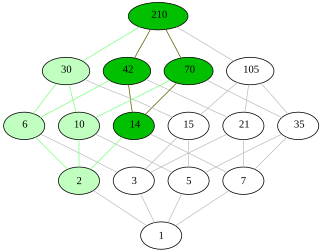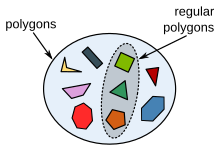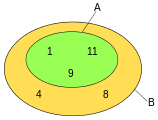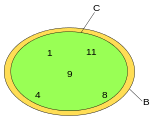In mathematics, a binary relation associates elements of one set, called the domain, with elements of another set, called the codomain. A binary relation over sets X and Y is a set of ordered pairs (x, y) consisting of elements x from X and y from Y. It is a generalization of the more widely understood idea of a unary function. It encodes the common concept of relation: an element x is related to an element y, if and only if the pair (x, y) belongs to the set of ordered pairs that defines the binary relation. A binary relation is the most studied special case n = 2 of an n-ary relation over sets X1, ..., Xn, which is a subset of the Cartesian product

In mathematics, especially order theory, a partial order on a set is an arrangement such that, for certain pairs of elements, one precedes the other. The word partial is used to indicate that not every pair of elements needs to be comparable; that is, there may be pairs for which neither element precedes the other. Partial orders thus generalize total orders, in which every pair is comparable.

In the mathematical field of order theory, an ultrafilter on a given partially ordered set is a certain subset of namely a maximal filter on that is, a proper filter on that cannot be enlarged to a bigger proper filter on
A mathematical symbol is a figure or a combination of figures that is used to represent a mathematical object, an action on mathematical objects, a relation between mathematical objects, or for structuring the other symbols that occur in a formula. As formulas are entirely constituted with symbols of various types, many symbols are needed for expressing all mathematics.

In mathematics, the symmetric difference of two sets, also known as the disjunctive union and set sum, is the set of elements which are in either of the sets, but not in their intersection. For example, the symmetric difference of the sets and is .
In mathematics, in the area of order theory, an antichain is a subset of a partially ordered set such that any two distinct elements in the subset are incomparable.
In mathematics, specifically order theory, a well-quasi-ordering or wqo on a set is a quasi-ordering of for which every infinite sequence of elements from contains an increasing pair with
In mathematics, a join-semilattice is a partially ordered set that has a join for any nonempty finite subset. Dually, a meet-semilattice is a partially ordered set which has a meet for any nonempty finite subset. Every join-semilattice is a meet-semilattice in the inverse order and vice versa.
In mathematics, a subset of a preordered set is said to be cofinal or frequent in if for every it is possible to find an element in that is "larger than ".
In set theory, a prewellordering on a set is a preorder on that is strongly connected and well-founded in the sense that the induced relation defined by is a well-founded relation.

In mathematics, an upper set of a partially ordered set is a subset with the following property: if s is in S and if x in X is larger than s, then x is in S. In other words, this means that any x element of X that is to some element of S is necessarily also an element of S. The term lower set is defined similarly as being a subset S of X with the property that any element x of X that is to some element of S is necessarily also an element of S.

In mathematics, specifically order theory, the join of a subset of a partially ordered set is the supremum of denoted and similarly, the meet of is the infimum, denoted In general, the join and meet of a subset of a partially ordered set need not exist. Join and meet are dual to one another with respect to order inversion.
In the mathematical field of set theory, an ideal is a partially ordered collection of sets that are considered to be "small" or "negligible". Every subset of an element of the ideal must also be in the ideal, and the union of any two elements of the ideal must also be in the ideal.
In mathematics, a filter on a set is a family of subsets such that:
- and
- if and , then
- If , and , then
In mathematics, a cardinal function is a function that returns cardinal numbers.
The Grzegorczyk hierarchy, named after the Polish logician Andrzej Grzegorczyk, is a hierarchy of functions used in computability theory. Every function in the Grzegorczyk hierarchy is a primitive recursive function, and every primitive recursive function appears in the hierarchy at some level. The hierarchy deals with the rate at which the values of the functions grow; intuitively, functions in lower levels of the hierarchy grow slower than functions in the higher levels.
In functional analysis, a branch of mathematics, a strictly singular operator is a bounded linear operator between normed spaces which is not bounded below on any infinite-dimensional subspace.

Filters in topology, a subfield of mathematics, can be used to study topological spaces and define all basic topological notions such as convergence, continuity, compactness, and more. Filters, which are special families of subsets of some given set, also provide a common framework for defining various types of limits of functions such as limits from the left/right, to infinity, to a point or a set, and many others. Special types of filters called ultrafilters have many useful technical properties and they may often be used in place of arbitrary filters.

In the mathematical field of set theory, an ultrafilter on a set is a maximal filter on the set In other words, it is a collection of subsets of that satisfies the definition of a filter on and that is maximal with respect to inclusion, in the sense that there does not exist a strictly larger collection of subsets of that is also a filter. Equivalently, an ultrafilter on the set can also be characterized as a filter on with the property that for every subset of either or its complement belongs to the ultrafilter.
![Euler diagram showing
A is a subset of B (denoted
A
[?]
B
{\displaystyle A\subseteq B}
) and, conversely, B is a superset of A (denoted
B
[?]
A
{\displaystyle B\supseteq A}
). Venn A subset B.svg](http://upload.wikimedia.org/wikipedia/commons/thumb/b/b0/Venn_A_subset_B.svg/150px-Venn_A_subset_B.svg.png)










































![A
[?]
B
{\displaystyle A\subseteq B}
and
B
[?]
C
{\displaystyle B\subseteq C}
implies
A
[?]
C
.
{\displaystyle A\subseteq C.} Subset with expansion.svg](http://upload.wikimedia.org/wikipedia/commons/thumb/d/df/Subset_with_expansion.svg/220px-Subset_with_expansion.svg.png)





















